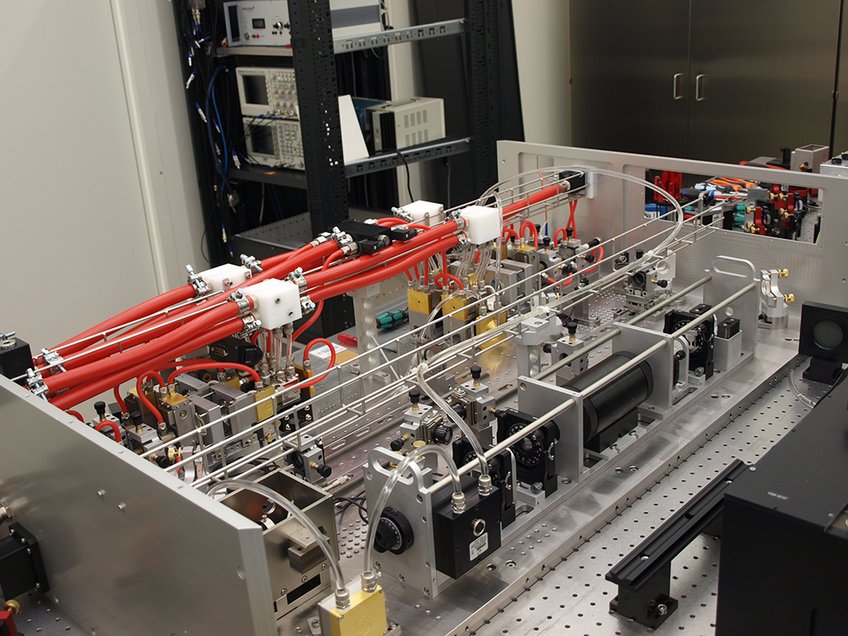Valuable cargo on the high seas
High-power lasers from Hannover on their way to the gravitational wave detector in the USA
The search for Einstein’s gravitational waves is like looking for a needle in a haystack. Moreover, imagine that the needle has a very similar nature to the hay itself. After all, cosmic gravitational waves, tiny tremors of space and time, are hard to differentiate from terrestrial tremors. Therefore, researchers are dependent upon efficient measuring instruments to actually find their needles - the gravitational waves. To accomplish this, they construct gravitational wave detectors which function according to the principle of laser interferometry. Scientists from the Max Planck Institute for Gravitational Physics (Albert Einstein Institute Hannover, AEI), together with the Laser Zentrum Hannover e.V. (LZH), have recently developed a high-power laser that will be deployed for the next generation of gravitational wave detectors. This laser is currently aboard the MSC Loretta, on the way to LIGO, one of these detectors in the USA.

Laser pointers usually shine red or green – at a rather weak output of less than 1 mW (milliwatt). In contrast to this, lasers that have thus far been used in gravitational wave astronomy, have an output of 10-50 watts. Thus, they are around ten thousand times brighter that those that we use in everyday life. What’s more, these light sources are not visible to the human eye, as they function in the infrared frequency range. These two characteristics make high-power lasers particularly advantageous for research purposes. The optical systems of the gravitational waves interferometer can “see” namely particularly sharply at infrared wavelengths. Plus: The higher the power of a laser, the more precise the measurements by the detectors.
The new high-power laser, which was developed for this purpose by a team of scientists headed by Dr. Benno Willke from the AEI, emits a beam that is again around ten times stronger than its predecessor. It has an output of 200 W at a wavelength of 1064 nm and sets itself apart through its unprecedented stability in terms of output and frequency. It is thus worldwide the first of its kind and the scientists will be mounting it in a gravitational wave detector.
More laser light for the new detectors
When it arrives in Livingston, USA, the laser will ring in a new era for gravitational wave detectors. “High-performance lasers of this type will be used in the new generation of gravitational wave detectors, such as Advanced LIGO,” says Willke. “This will allow the measuring sensitivity of these detectors to be improved by again a factor of 10.”
And according to Prof. Karsten Danzmann, Director at the Max Planck Institute for Gravitational Physics, and head of the Institute for Gravitational Physics at Leibniz Universität Hannover: “This will radically increase the probability of a direct measurement of gravitational waves in the next few years.”
The concept for the laser was conceived by the physicists in the Working Group headed by Benno Willke from the AEI in close cooperation with the Laser Zentrum Hannover e.V. The laser itself was developed and constructed at the LZH. The scientists at the AEI developed the components for the stabilization of the laser and tested them over the last few weeks. Now, the laser and stabilization components, well-cushioned and packed watertight, are in a container on the freighter MSC Loretta, travelling over the waves to fulfil their destiny.
Gravitational waves
Gravitational waves are tiny, wave-like disturbances in space-time. They follow on the assumptions of the general theory of relativity, which Albert Einstein proposed around a century ago. They arise when massive cosmic objects such as black holes merge with one another, when a star gives up its life in a supernova explosion, or when two pulsars closely orbit each other. To date, astronomers have only been able to prove them indirectly with double pulsar systems. Their direct observation has yet to be achieved. Already today, we can observe the universe in numerous wavelengths: with the help of telescopes that survey the cosmos in the optical, infrared, gamma and x-ray areas. We nevertheless only see a tiny segment, as we cannot see around 96% of the universe with our conventional telescopes. With gravitational wave astronomy, which does not search for electromagnetic radiation but rather for disturbances in space-time, we will thus gain completely new insights. The direct proof of gravitational waves is therefore one of the most exciting tasks facing modern physics, and is the goal of global cooperative efforts.
